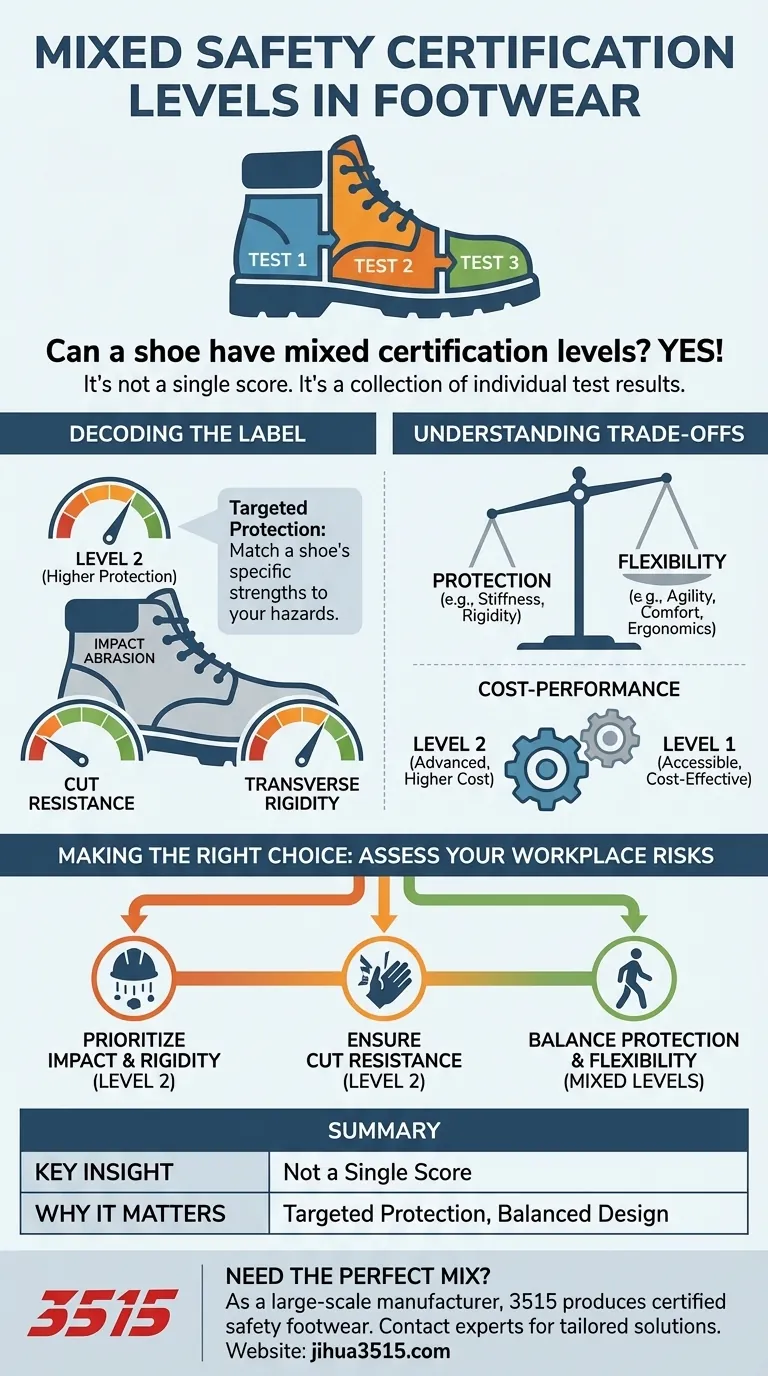Yes, a safety shoe can absolutely have mixed certification levels. A boot might achieve a higher protection level, such as Level 2, in a test for impact abrasion but only meet the standard for Level 1 in a different test, like transverse rigidity. The certification label on the shoe is designed to clearly display these individual results for each specific test it has undergone.
The key is to understand that a shoe's safety rating isn't a single, overall score. Instead, it's a collection of individual performance scores for different types of protection, allowing you to match a shoe's specific strengths to your specific workplace hazards.

Decoding the Safety Label: A Test-by-Test System
When you look at a safety footwear label, you are not seeing one overarching grade. You are seeing the results of a series of independent tests, each designed to measure resistance to a specific type of hazard.
The Purpose of Individual Ratings
This component-based system is intentional. A roofer and a warehouse worker face very different daily risks.
The roofer might prioritize a high rating for slip resistance and flexibility, while the warehouse worker needs exceptional impact protection and resistance to crushing forces.
By providing separate scores, the certification allows professionals to choose footwear optimized for the real-world hazards they will actually encounter.
Common Tests and Their Levels
While specific standards can vary, safety footwear is generally tested for a core set of protective qualities. Each of these tests has its own performance benchmarks, often categorized as Level 1 or Level 2.
- Impact Abrasion: This measures how well the boot's material withstands being scraped or worn down by rough surfaces.
- Cut Resistance: This tests the upper material's ability to resist a blade, a critical feature when working with sharp tools or materials.
- Transverse Rigidity: This measures the sole's resistance to being crushed from side to side, protecting the foot's metatarsal bones. A boot might need to be very flexible for certain jobs, making a Level 1 rating in this specific test perfectly acceptable or even desirable.
Understanding the Trade-offs in Footwear Design
It's crucial to recognize that achieving the highest level in every single category is not always practical or even desirable. Engineering a boot involves balancing competing priorities.
Protection vs. Flexibility
A boot with a Level 2 rating for transverse rigidity will have an extremely stiff and rigid sole. While this offers maximum protection from crushing, it can also be heavy and reduce flexibility, leading to fatigue over a long workday.
For a worker who needs to be agile, a boot with a Level 1 rating for rigidity but a Level 2 rating for impact abrasion might be a far better and safer choice.
Cost vs. Performance
Materials that offer Level 2 performance across the board are often more advanced and expensive. A manufacturer might design a boot with Level 2 protection for the most common risks in a specific trade (like cuts) while using Level 1-rated components for less critical areas to create a more accessible price point.
This isn't about cutting corners; it's about delivering targeted, cost-effective protection for a specific job's risk profile.
Making the Right Choice for Your Goal
Ultimately, the "best" safety shoe is the one with the right combination of ratings for your specific environment. Always start by performing a risk assessment of your own workplace.
- If your primary focus is protection from falling objects and heavy machinery: Prioritize high ratings (Level 2) for impact protection and transverse rigidity.
- If your primary focus is working with sharp materials like glass or sheet metal: Ensure the boot has a Level 2 rating for cut resistance.
- If your primary focus is agility, comfort, and walking long distances: A mix of Level 2 ratings for key hazards (like abrasion) and Level 1 for others (like rigidity) may provide the best balance of safety and ergonomics.
By reading the label carefully, you can make an informed decision that goes beyond a simple brand name and truly protects you from the hazards you face every day.
Summary Table:
| Key Insight | Why It Matters |
|---|---|
| Not a Single Score | A shoe's safety rating is a collection of individual test results, not one overall grade. |
| Targeted Protection | Allows you to match a shoe's specific strengths (e.g., cut resistance) to your specific workplace hazards. |
| Balanced Design | Enables a better balance between protection, flexibility, comfort, and cost. |
Need Safety Footwear with the Perfect Mix of Certifications?
As a large-scale manufacturer, 3515 produces a comprehensive range of certified safety footwear for distributors, brand owners, and bulk clients. We can help you source or create the ideal boots with the exact combination of protection levels (like impact abrasion, cut resistance, and transverse rigidity) required for your specific industry and workforce.
Contact our experts today to discuss your safety requirements and get a tailored solution.
Visual Guide

Related Products
- Safety Footwear Wholesale Manufacturer for Custom OEM/ODM Production
- Premium Suede Sport Safety Shoes for Wholesale & Bulk Orders
- Premium Flame-Retardant Waterproof Safety Boots and Shoes
- Advanced KPU Athletic Safety Shoe with Steel Toe Cap Anti-Slip Rotary Lacing System
- Premium Waterproof High-Cut Industrial Safety Boots for Wholesale and Bulk Orders
People Also Ask
- Do snake bite boots work? Your Ultimate Guide to Effective Snake Bite Protection
- What are OSHA approved shoes? Understanding the Correct Standards for Workplace Safety
- Is it normal to wear shoes in the house? A Guide to Hygiene, Comfort & Culture
- What do heavy duty boots do? Protect Your Feet in Demanding Work Environments
- How long can you wear safety boots? The Lifespan is Determined by Wear, Not Time



















